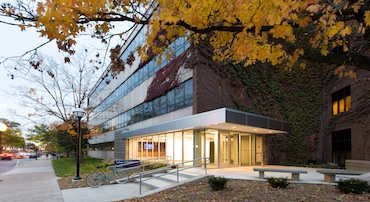Sherman Lab Collaboration Takes Major Stride Forward in Understanding Microorganism Biosynthesis

In the June 26, 2014 issue of Nature, Dr. David Sherman, and collaborators have taken a major stride forward in understanding how the biochemical ‘machinery’ in microbes containing the step-by-step blueprints for natural product synthesis is operating. The team consisting of Dr. Kristina Häkansson, Dr. Georgios Skiniotis, Dr. Janet Smith, and Dr. Sherman have described the specific role of acyl carrier protein in combination with other catalytic domains in the molecular assembly line for biosynthesis of the complex antibiotic, pikromycin.
“The threats of antibiotic resistance keep growing and we are in urgent need of new drugs,” states Dr. Sherman. “Now that we can see how the machine is working, we can understand why previous attempts to engineer these natural factories to make drugs have failed—and how we might be able to do it better.”
Dr. Sherman is the Hans W. Vahlteich Professor of Medicinal Chemistry and Associate Dean for Research and Graduate Education and has been working for over fifteen years to unravel the mysteries of antibiotic production by terrestrial and marine bacteria with the aim of discovering new drugs. Since 2000, more than half of the FDA approved compounds for use as antimicrobial agents have been derived from natural products. These compounds were isolated from terrestrial sources with the majority of the compounds isolated from other microorganisms.
“I think that nature is probably the best source from which to seek weapons against their fellow organisms,” explains Dr. Ronald Woodard, “Dr. Sherman’s bioprospecting efforts of the marine environment represent a new and very exciting source for potential antibiotics.”
Dr. Woodard, the F.F. Blicke Collegiate Professor in Medicinal Chemistry, is interested in finding small molecules that are capable of interfering with the biosynthesis the lipopolysaccharide (LPS) outer membrane of Gram-negative microorganism. A product spawned from LPS technology in Dr. Woodard’s lab involved a medicinal chemistry graduate student, Dr. Tim Meredith, as co-inventor and was named one of the top 10 innovations in the life sciences in 2013.
A medicinal chemistry graduate student, Douglas Hansen in Dr. Sherman’s lab is a co-author on both Nature papers. He was responsible for the synthesis of the thiophenol-activated pentaketide substrate, and also developed state-of-the-art methods for conducting the key functional assays for the biochemical machine (polyketide synthase module) that catalyzes chain elongation and processing of the antibiotic intermediate.
As Chair of the Department of Medicinal Chemistry, Dr. George Garcia proudly acknowledges the role of the many gifted graduate student researchers in medicinal chemistry research programs. Dr. Garcia’s own research program is also in the area of antibiotic drug discovery and involves the search for compounds that will modify microorganism virulence so that the organism survives yet is innocuous.
“Doug is an unusually innovative student, and rigorous experimentalist,” asserts Dr. Garcia. “This collaborative project involving a medicinal chemistry graduate student is yet another example of the overlap of education and research furthering drug discovery efforts at the College of Pharmacy.”
To read more about these discoveries and the research programs of medicinal chemistry faculty, please visit:
Medicinal Chemistry Research
Nature's Chem Lab: How microorganisms manufacture drugs
Woodard Lab Discovery
In a separate discovery, Dr. Sherman has also recently uncovered a new class of antibiotics active against MRSA and anthrax.



